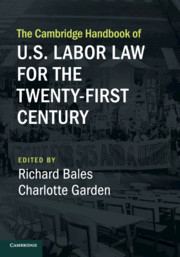Book contents
- Advance Praise for The Cambridge Handbook of U.S. Labor Law for the Twenty-First Century
- The Cambridge Handbook of U.S. Labor Law for the Twenty-First Century
- The Cambridge Handbook of U.S. Labor Law for the Twenty-First Century
- Copyright page
- Contents
- Contributors
- Preface
- Acknowledgments
- Part I Introduction
- Part II Labor Law Is Out of Date
- Part III The “Fissured” Workplace
- Part IV Barriers to Forming a Collective Bargaining Relationship
- 17 Tactical Mismatch in Union Organizing Drives
- 18 The Power of Place
- 19 Assembly and Collective Rights
- 20 Leveraging Secondary Activity Within and Outside Legal Boundaries
- 21 Captive Audience Meetings
- Part V Barriers to Bargaining a Good Contract
- Part VI Unions, Civil Society, and Culture
17 - Tactical Mismatch in Union Organizing Drives
from Part IV - Barriers to Forming a Collective Bargaining Relationship
Published online by Cambridge University Press: 01 November 2019
- Advance Praise for The Cambridge Handbook of U.S. Labor Law for the Twenty-First Century
- The Cambridge Handbook of U.S. Labor Law for the Twenty-First Century
- The Cambridge Handbook of U.S. Labor Law for the Twenty-First Century
- Copyright page
- Contents
- Contributors
- Preface
- Acknowledgments
- Part I Introduction
- Part II Labor Law Is Out of Date
- Part III The “Fissured” Workplace
- Part IV Barriers to Forming a Collective Bargaining Relationship
- 17 Tactical Mismatch in Union Organizing Drives
- 18 The Power of Place
- 19 Assembly and Collective Rights
- 20 Leveraging Secondary Activity Within and Outside Legal Boundaries
- 21 Captive Audience Meetings
- Part V Barriers to Bargaining a Good Contract
- Part VI Unions, Civil Society, and Culture
Summary
The well-known decline in union density in the United States masks an important divide: the union membership rate for public sector workers (34.4 percent in 2017) is more than five times higher than that of private sector workers (6.5 percent in 2017). That divide is even more remarkable when one considers that some states lack public sector collective bargaining statutes or even affirmatively prohibit public sector collective bargaining, and therefore have considerably lower public sector union density than states with robust bargaining regimes. Yet this divide is not explained by workers’ own preferences in the public and private sector; the labor economist Richard Freeman has found that significant numbers of nonunion workers desire union representation, and more recent polling shows robust support for unions in general. If workers’ own desires for union representation do not explain the gap between private and public sector representation, then what does? This chapter explores a pair of related likely culprits: private employers’ and outside groups’ abilities to fight union drives through highly effective and legal “union avoidance” campaigns, and weak deterrents that give employers few reasons to fear committing unfair labor practices or violating the “laboratory conditions” doctrine while persuading employees to vote against union representation.
- Type
- Chapter
- Information
- Publisher: Cambridge University PressPrint publication year: 2019
- 1
- Cited by



